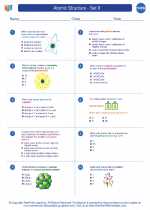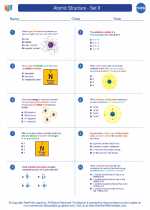Atomic Structure - Set II
1. What is an atomic number?
The atomic number of an element is the number of protons found in the nucleus of an atom of that element. It is denoted by the letter Z.
2. What is an isotope?
An isotope is a variant of a particular chemical element which differs in neutron number. All isotopes of a given element have the same atomic number but different mass numbers.
3. Define mass number.
The mass number of an atom is the sum of the number of protons and the number of neutrons in the nucleus of an atom. It is denoted by the letter A.
4. Explain the concept of atomic mass.
Atomic mass is the average mass of an element's atoms, taking into account the abundance of isotopes. It is expressed in atomic mass units (u).
5. What is the significance of the Bohr model of the atom?
The Bohr model introduced the concept of quantized energy levels in an atom. It successfully explained the spectrum of the hydrogen atom and provided a framework for understanding the electronic structure of atoms.
Study Guide
- Understand the relationship between atomic number, mass number, and isotopes.
- Learn to calculate the atomic mass of an element based on its isotopic abundance.
- Explore the limitations of the Bohr model and how it was improved upon by the modern quantum mechanical model of the atom.
- Practice identifying elements based on their atomic number and mass number.
[Atomic Structure - Set II] Related Worksheets and Study Guides:
.◂Chemistry Worksheets and Study Guides High School. Atomic Structure - Set II

 Worksheet/Answer key
Worksheet/Answer key
 Worksheet/Answer key
Worksheet/Answer key
